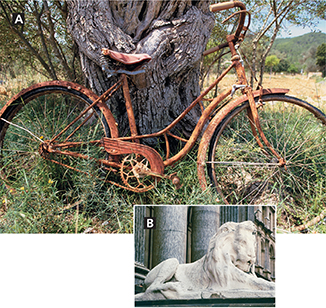Chemical weathering also occurs because rain is slightly acidic. Water and carbon dioxide naturally combine to form carbonic acid. The carbonic acid in rainwater dissolves many minerals, such as calcite. The statue of the lion in Figure 9 has been weathered by carbonic acid in rain. Carbonic acid and water react with other minerals, such as the feldspar in granite, to produce clay minerals.
Another type of chemical weathering, the rusting of minerals that are rich in iron, involves oxidation. This results in the formation of new minerals that often have a red or brown color, such as the rusted bicycle in Figure 9.

What is the main agent of chemical weathering?
Rates of Weathering
 The rate at which mechanical and chemical weathering take place depends on three main factors: temperature, the availability of water, and the type of rock. Chemical weathering occurs more rapidly in places with high temperatures and abundant rainfall. These conditions generally speed up chemical reactions. For example, granite weathers slowly in cool regions, but more rapidly in regions that are hot and wet. Mechanical weathering occurs faster in places where temperature conditions frequently alternate between freezing and thawing.
The rate at which mechanical and chemical weathering take place depends on three main factors: temperature, the availability of water, and the type of rock. Chemical weathering occurs more rapidly in places with high temperatures and abundant rainfall. These conditions generally speed up chemical reactions. For example, granite weathers slowly in cool regions, but more rapidly in regions that are hot and wet. Mechanical weathering occurs faster in places where temperature conditions frequently alternate between freezing and thawing.
The rate of weathering also depends upon the kind of rock that is exposed at the surface. Some rocks, such as limestone and marble, undergo rapid chemical weathering. These rocks are composed primarily of calcite, a mineral that reacts readily with carbonic acid. One of the tombstones in Figure 10 shows the effects of chemical weathering on marble. In contrast, the other tombstone is made of slate, which is composed of minerals, such as quartz and mica, that are much more resistant to chemical weathering than calcite.
Figure 9 In chemical weathering, rock is broken down by chemical reactions. A One form of chemical weathering occurs through oxidation. Iron-rich minerals become rusted like this old bicycle. B Chemical weathering also occurs when rainwater dissolves or reacts with the minerals in rocks, as with this statue of a lion.

Figure 10 Different rocks weather at different rates. Even though the slate tombstone (right) is older, it is much less weathered than the marble one (left). Inferring What type of weathering was likely responsible for wearing away the lettering on the marble tombstone?





